Coldwater fish is a bit of a misnomer. Cool water fish would probably be a better term, but it doesn’t quite roll off the tongue as well.
A true cold water fish would be something like salmon or cod that can live in temperatures at or below freezing.
But, the fish we’re going to be discussing in this article can really, at most, handle temperatures down in the 50s.
But, I digress. Coldwater is the accepted term in this case, so that’s what I’ll stick with.
Most fish in the aquarium trade are tropical fish, meaning they require water temperatures in the mid-70s and higher. Unless the temps inside your home stay quite warm all year round, you’d need to heat your aquarium in order for tropical fish to survive.
By contrast, coldwater fish can thrive at temps below 70°F (21°C). This means, as long as the ambient air temperature doesn’t dip below the high 60s, there’s no reason to add a heater to their tank or pond.
Here are my top coldwater fish you can consider for your aquarium.
Coldwater Fish Species
1. Fancy Goldfish

- Minimum tank: 40 gallon (151 liter)
- Temperature: 65°-72°F (18°-22°C)
- Diet: omnivore
- Behavior: mostly peaceful but will try to eat smaller fish
Goldfish are a great go-to coldwater fish, but just remember, they need very large tanks. A single fancy Goldfish will need at least a 40 gallon tank, a pair will need a 75 gallon (284 liter). Also, Goldfish will destroy most aquarium plants. But, an adult fantail is a gorgeous sight swimming around your tank, and is well worth the effort.
2. Zebra Danio

- Minimum tank: 10 gallon (39 liter)
- Temperature: 65°-75°F (18°-24°C)
- Diet: omnivore
- Behavior: peaceful schooling fish, keep a group of 5 or more
These guys are little hyperactive wonders that always add interest to a coldwater aquarium. They’re such cute nano fish; their blue and gold pinstripes are very eye-catching. Zebra danios love to swim against a strong current. So, I recommend adding a powerhead to your tank to increase the water flow. They’re easy keepers, just make sure that you crush up their food small enough to fit in their tiny mouths.
3. White Cloud Mountain Minnow
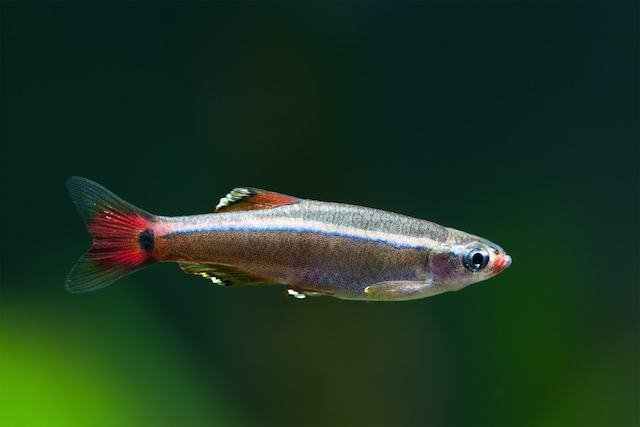
- Minimum tank: 10 gallon (39 liter)
- Temperature: 60°-75°F (16°-24°C)
- Diet: omnivore
- Behavior: peaceful schooling fish, keep a group of 5 or more
White clouds are another adorable nano fish that I think are really underrated. Frequently, they’re sold as feeder fish. Their color can be very muted in the live fish store tanks. But once they’re established in a home tank, their bodies are a dusky gold with red tips on their fins. They’re really quite pretty. Extremely hardy, interesting to watch, easy to care for and undemanding, there really isn’t a downside to this species.
4. Pearl Danio
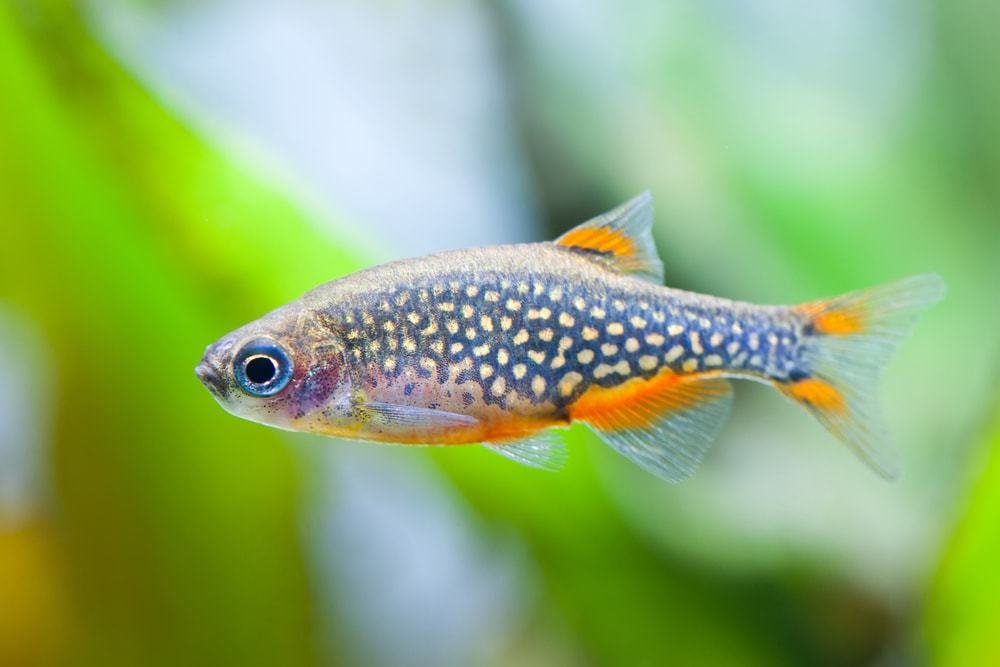
- Minimum tank: 20 gallon (76 liter)
- Temperature: 65°-75°F (18°-24°C)
- Diet: omnivore
- Behavior: peaceful schooling fish, keep a group of 5 or more
This little fish shouldn’t be confused with its more colorful cousin, the celestial pearl danio. Pearl danios aren’t as showy as celestial danios, but they are a hardier fish. They’ve been in the aquarium trade since the early 20th century, because they are easy to care for and can tolerate cold water setups.
5. Endler’s Livebearer
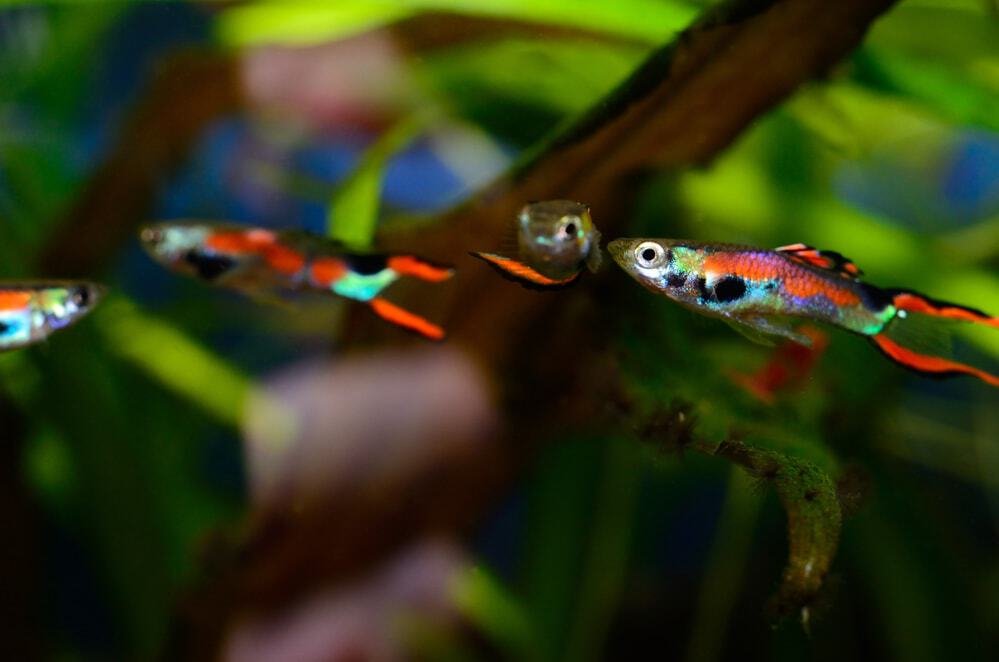
- Minimum tank: 5 gallon (19 liter)
- Temperature: 65°-82°F (18°-28°C)
- Diet: omnivore
- Behavior: peaceful schooling fish, keep a group of 5 or more
The Endler’s livebearer is probably the most colorful fish on this list. They look like you asked a little kid to draw you a picture of a fish and then the child used every bright color in their box of crayons. They’re related to guppies (you’ll sometimes see them listed as an Endler’s guppy). It’s been my experience that Endlers are hardier and longer-lived than fancy guppies. The females are rather drab. I would recommend keeping a tank with all males.
6. Gold Barb
- Minimum tank: 40 gallon (151 liter)
- Temperature: 65°-75°F (18°-24°C)
- Diet: omnivore
- Behavior: peaceful schooling fish, keep a group of 5 or more
The wild form of this fish is found throughout Northern and Southeast Asia. Their color is much duller in the wild; the brightly colored fish you see in the live fish store are the product of selective breeding. Gold barbs will do best in a large group. A bigger group helps make them feel more secure and will reduce any fin nipping within the school.
7. Rosy Barb
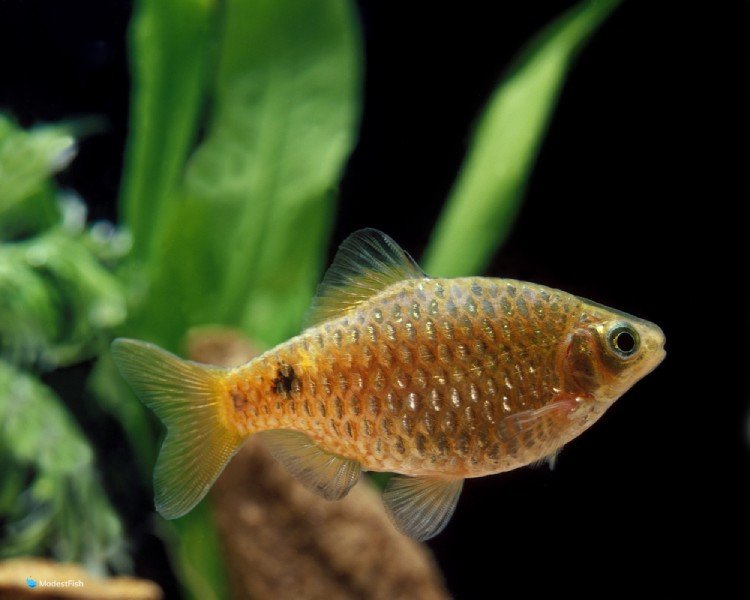
- Minimum tank: 55 gallon (208 liter)
- Temperature: 65°-72°F (18°-22°C)
- Diet: omnivore
- Behavior: peaceful schooling fish, keep a group of 5 or more
Rosy barbs are another peaceful schooling fish, but they grow to be 4 inches long, much larger than a lot of the community fish available in the hobby. You will need a much bigger aquarium to accommodate a school of rosy barbs because of their size. But, as long as your tank is large enough, this fish is colorful (especially during breeding season) and undemanding.
8. Hillstream Loach
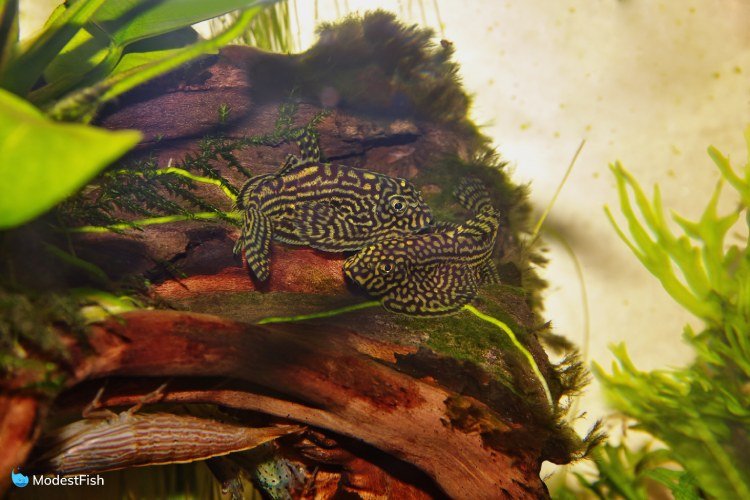
- Minimum tank: 55 gallon (208 liter)
- Temperature: 68°-75°F (20°-24°C)
- Diet: omnivore
- Behavior: peaceful schooling fish, keep a group of 5 or more
Hillstream loaches are an awesome little oddball with a very unique body shape. They look kind of like a butterfly and a stingray had a baby. Their bodies are dorsoventrally compressed, meaning flattened from top to bottom. This unique body shape helps them cling to rocks and logs in extremely fast moving water. These fish need a lot of current and oxygenation. I recommend adding on things like an airstone to add oxygen and a powerhead to add current. They are fairly good algae eaters and are just so neat to watch.
9. Dwarf Rasboras
- Minimum tank: 5 gallon (19 liter)
- Temperature: 68°-82°F (20°-28°C)
- Diet: omnivore
- Behavior: peaceful schooling fish, keep a group of 5 or more
The dwarf rasboras is very similar to the chili rasboras, but it can tolerate cooler temperatures. This fish is a mid and bottom dwelling species. Males become a vivid red color when they are spawning. This species is super tiny, making it ideal for smaller setups. The larger the group, the more interesting their schooling behavior will be.
10. Clown Killifish
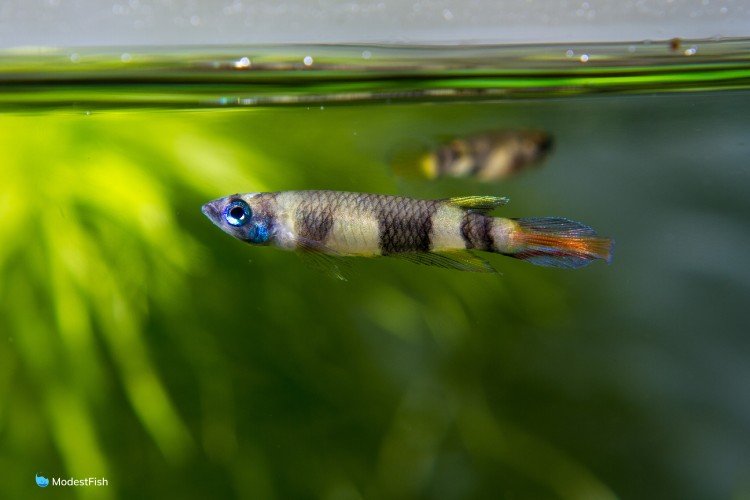
- Minimum tank: 10 gallon (39 liter)
- Temperature: 68°-79°F (20°-26°C)
- Diet: omnivore
- Behavior: peaceful schooling fish, keep a group of 5 or more
Clown killifish are a top-dwelling species that can tolerate temperature dips down into the upper 60s. Males have a very colorful tail, so you may be tempted to load the tank with just them. But that will cause all the males to squabble with each other. It’s recommended to keep a school that has a ratio of 2-3 females per one male.
11. Sunset Variatus Platy
- Minimum tank: 10 gallon (39 liter)
- Temperature: 61°-75°F (16°-24°C)
- Diet: omnivore
- Behavior: peaceful schooling fish, keep a group of 5 or more
I love that this species of platy can handle cool water. I love platies. They’re so active and goofy. They’ve always got something going on. Variable platies make a great pond or water feature fish. Native to Mexico, this little livebearer prefers harder water. So, you may need to add Wonder Shells or some other mineral additive to your tank if your water is really soft.
12. Rainbow Shiner
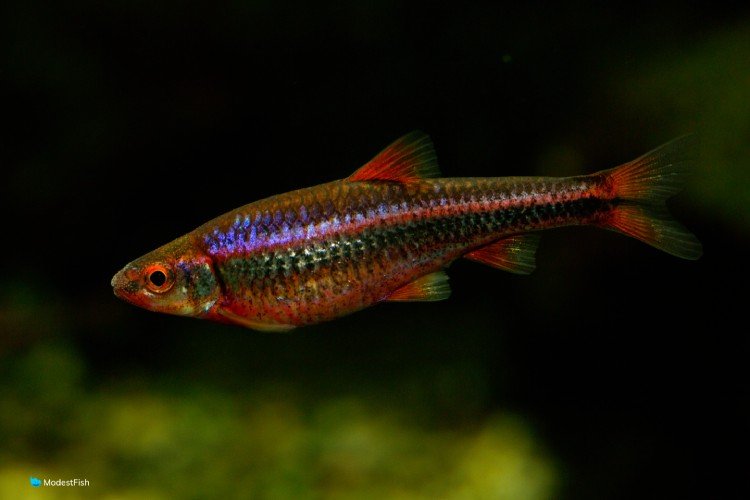
- Minimum tank: 20 gallon (90 liters)
- Temperature: 50°-72°F (10°-22°C)
- Diet: omnivore
- Behavior: peaceful schooling fish, keep a group of 5 or more
The rainbow shiner is a super cute minnow that is native to North America. They truly live up to their name with stripes of bright red and blue, mixed with patches of iridescent color, that run from their noses to their tails. These hardy and active fish can withstand temperatures down into the 50s.
13. Paradise Fish
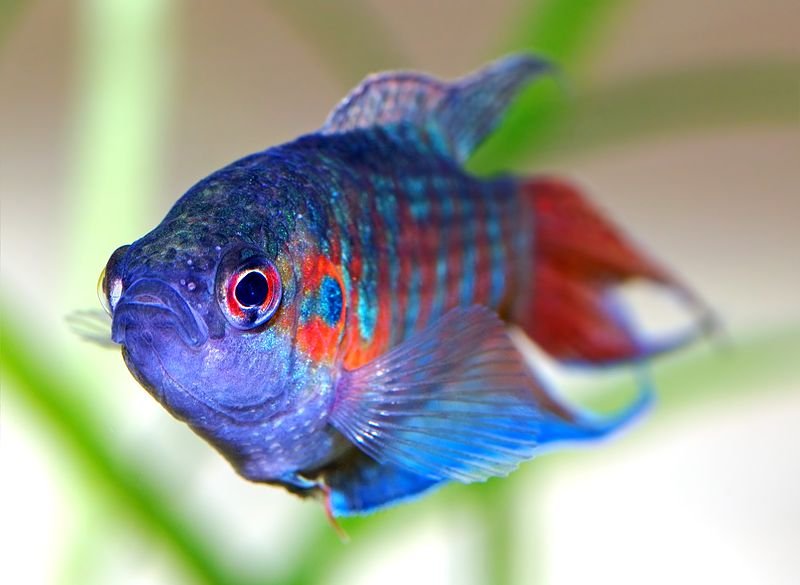
- Minimum tank: 20 gallon (90 liters)
- Temperature: 61°-79°F (16°-26°C)
- Diet: omnivore
- Behavior: peaceful with other species as long as they are bigger than the paradise fish, but quite aggressive with its own kind. Keep only one male in your tank. Cannot be kept with other gourami species.
Paradise fish are absolutely stunning. But, there is a price to pay for all that beauty. These fish are undemanding and hardy, but they can have a downright nasty attitude. It’s not recommended to keep more than one male in your tank, as two males will fight with each other, probably until death. You can keep them with other species, but the other fish need to be larger than the paradise fish and you can’t mix them with other gouramis.
14. Mosquito Fish
- Minimum tank: 10 gallon (39 liter)
- Temperature: 50°-82°F (10°-28°C)
- Diet: carnivore
- Behavior: peaceful schooling fish, keep a group of 5 or more
This nifty little livebearer is a great addition to any pond. The mosquito fish can eat up hundreds of mosquito larvae every single day. They are a great way to keep down hungry blood sucking hordes of insects from your backyard water feature. These little guys are pretty cute, their color is kind of drab, but they have the same body shape and big eyes as platies. And hey, anything that will keep down mosquitoes is all right with me.
15. Japanese Rice Fish
- Minimum tank: 10 gallon (39 liter)
- Temperature: 64°-75°F (18°-24°C)
- Diet: omnivore
- Behavior: peaceful schooling fish, keep a group of 5 or more
These adorable little fish are some of the hardiest in the hobby. Japanese rice fish will show off their colors best against a dark substrate. If they’re kept in a tank with a light colored substrate, they will mute their colors to better blend into the background. This species will do best in a densely planted tank that provides them lots of cover. Lots of hiding places will make them feel secure, and so, they will be more likely to come out into the open.
16. Bloodfin Tetra
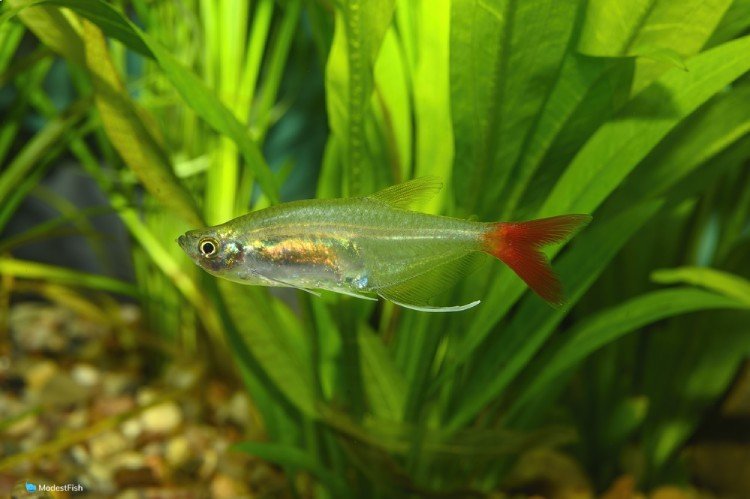
- Minimum tank: 30 gallon (113 liter)
- Temperature: 64°-82°F (16°-28°C)
- Diet: omnivore
- Behavior: peaceful schooling fish, keep a group of 5 or more
Bloodfin tetras are very striking. They have a bluish silver color on their bodies and bright, bright red fins, super cute. These guys are another small, peaceful schooling fish that should be kept in a group of five or more. Despite being tiny, bloodfin tetras can live to be over 10 years old. So, they’re a bit of a commitment, but it means you’ll get to enjoy their beautiful colors for many years to come.
17. Bristlenose Pleco
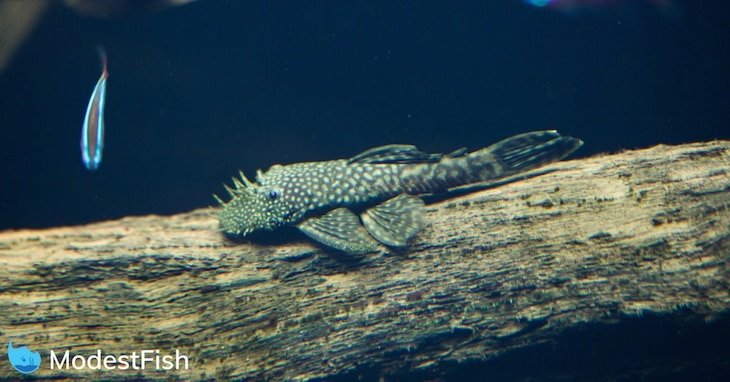
- Minimum tank: 30 gallon (113 liter)
- Temperature: 75°-80°F (24°-27°C)
- Diet: herbivore
- Behavior: peaceful with other species but will highly territorial with other plecos
Bristlenose plecos are one of my all time favorite fish. They’re a great cleaner fish and such an interesting oddball. Males especially, with their thick growth of facial bristles, are so ugly they’re cute. They are highly territorial with other plecos, but they will mostly just ignore other kinds of fish. These fish are fairly effective algae eaters. I’m not saying they will keep your tank 100% algae free, but they’ll put a major dent in it.
Keeping Coldwater fish
Keeping an unheated aquarium does limit your choice of fish, but there is still a pretty good variety to choose from. Every fish on this list is hardy and undemanding, making them good choices for beginners.
Just remember, you can skip the heater with these fish, but not the filtration! For more information about the importance of filtration and the Aquarium Nitrogen Cycle, see our detailed article here.
I think my personal favorites from this list are Endler’s livebearers and hillstream loaches.
Endlers are so colorful and interesting that they’re easily the stars of a tank. They’d do great alongside the loaches, who would eat up any food that got past the Endlers.
I hope you find this article helpful.
I wish you and your fish the very best!
